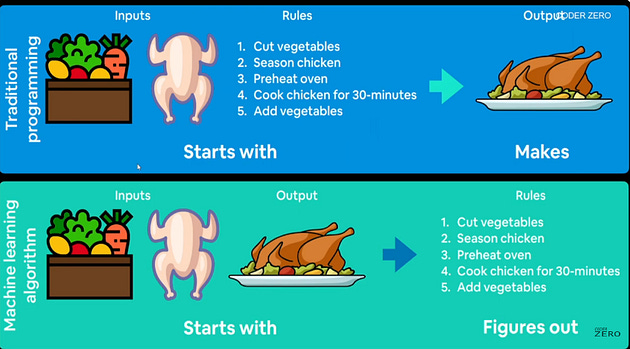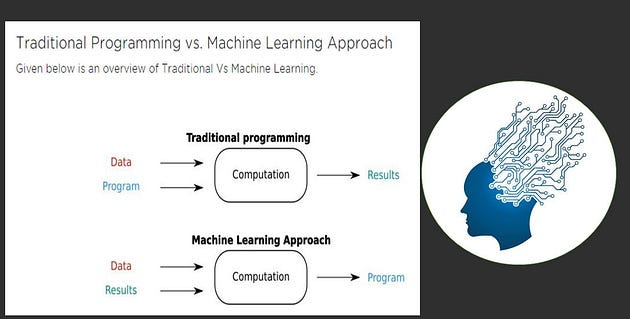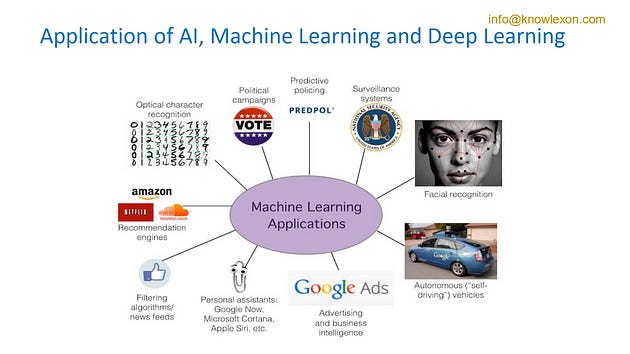Why Machine Learning? A Comprehensive Guide to ML Basics, Use Cases, and Benefits
ML(Part 2)
📚Chapter 1: Introduction to Machine Learning
If you want to read more articles about Machine Learning, don’t forget to stay tuned :) click here.
Sections
1- Why we used Machine Learning?
2- What is machine learning (ML)?
3- Difference between ML and traditional Programming
Section 1- Why we used Machine Learning
Before machine learning became mainstream, programmers wrote rules derived from a function of their domain knowledge, observation of some hand-picked instances, and the business requirement to perform a particular task. But this legacy way of delivering business results suffered some evident constraints.
Hand-written rules are limited by the knowledge of what edge cases a programmer can cover. This concept is very well explained by one of the most highly cited papers in the world of psychology titled “The Magical Number Seven, Plus or Minus Two: Some Limits on Our Capacity for Processing Information.”
Commonly cited as Miller’s law, the paper describes the limited amount of information an average brain can hold and how it becomes unmanageable with the increasing number of variables and dimensions.
Data is dynamic by nature and has become more so over the last decade with the proliferation of technology in our day-to-day lives. The varying data patterns fed to static pre-written rules are of little help to the business in taking meaningful actions. That is where the pattern mining ability of machine learning algorithms is put to the best use
Let’s take an example of a fraud detection case. The programmer would write rules that if the transaction amount is above $10K, transaction location is X, and it is made from a particular type, i.e., wire transfer, then it is flagged as a potentially fraudulent transaction.This could work like a charm for some time until the bad actors find an intelligent way to commit fraud. The conventional hard-coded rules are no more effective in detecting fraud. As their way of operation evolves, our fraud detection system needs to become too.
Further, all the software development processes are highly collaborative? — ?what if the developer who wrote the initial rules is no longer associated with the fraud detection project? And the new developer tasked with upgrading the logic has no understanding of the previous system and is skeptical about whether the recent changes will have backward compatibility. To summarize, updating a rule-based system is not only a cumbersome process but unscalable too.
That’s where machine learning algorithms come to our rescue. If the metrics are well-defined and well-aligned with the business objective, it continues to learn from the new training data and evolves into a sophisticated machine learning system.
Section1- What is learning.
The goal of Machine Learning is to make machines act more and more like humans because the smarter they get, the more they help us humans accomplish our goals.
Example
let us begin by considering a couple of examples from naturally occurring animal learning.
Bait Shyness — Rats Learning to Avoid Poisonous Baits: When rats encounter food items with novel look or smell, they will first eat very small amounts, and subsequent feeding will depend on the flavor of the food and its physiological effect. If the food produces an ill effect, the novel food will often be associated with the illness, and subsequently, the rats will not eat it. Clearly, there is a learning mechanism in play here.– the animal used past experience with some food to acquire expertise in detecting the safety of this food. If past experience with the food was negatively labeled, the animal predicts that it will also have a negative effect when encountered in the future.
Inspired by the preceding example of successful learning, let us demonstrate a typical machine learning task. Suppose we would like to program a machine that learns how to filter spam e-mails. A naive solution would be seemingly similar to the way rats learn how to avoid poisonous baits. The machine will simply memorize all previous e-mails that had been labeled as spam e-mails by the human user. When a new e-mail arrives, the machine will search for it in the set of previous spam e-mails. If it matches one of them, it will be trashed. Otherwise, it will be moved to the user’s inbox folder.
While the preceding “learning by memorization” approach is sometimes useful, it lacks an important aspect of learning systems — the ability to label unseen e-mail messages. A successful learner should be able to progress from individual examples to broader generalization. This is also referred to as inductive reasoning or inductive inference. In the bait shyness example presented previously, after the rats encounter an example of a certain type of food, they apply their attitude toward it on new, unseen examples of food of similar smell and taste. To achieve generalization in the spam filtering task, the learner can scan the previously seen e-mails, and extract a set of words whose appearance in an e-mail message is indicative of spam. Then, when a new e-mail arrives, the machine can check whether one of the suspicious words appears in it, and predict its label accordingly. Such a system would potentially be able correctly to predict the label of unseen e-mails.
Section 2- What is machine learning?
Machine learning comes under artificial intelligence. Artificial intelligence is an umbrella term that contains many realms like machine learning, image processing, neural networks, cognitive science, and many more. AI is an umbrella discipline that covers everything related to making machines smarter.In this blog post, we will explore the basics of machine learning .
Definition 1: Machine learning is a branch of artificial intelligence (AI) that focuses on developing algorithms and statistical models that enable computer systems to learn from experiences or past data like we human p, identify patterns, and make predictions or decisions without being explicitly programmed. Arthur Samuel in 1959, first coined the term machine learning.
Definition: 2: The capability of Artificial Intelligence systems to learn by extracting patterns from data is known as Machine Learning is the idea to learn from examples and experiences without being explicitly programmed or hand-written rule. Instead of writing code, you feed data to the generic algorithm and it builds logic based on the data given.
Definition: 3 Machine Learning (ML) is commonly used along with AI but it is a subset of AI. ML refers to an AI system that can self-learn based on the algorithm. Systems that get smarter and smarter over time without human intervention are ML Machine learning is the study of Computer Algorithms that allow computer programs to automatically improve through experience Or In ML machines can learn by themselves without being explicitly programmed.
Definition: Machine learning allows a machine to automatically learn from data, enhance its performance from experiences, and thus predict things without being explicitly programmed or requiring any human intervention.
Definition: 4 Machine learning is a branch of study that allows machines to learn patterns from data without the involvement of explicit programming. The learnings are based on their experiences without human interference.
Definition: 5 : Machine learning is the idea that there are generic algorithms that can tell you something interesting about a set of data without you having to write any custom code specific to the problem. Instead of writing code, you feed data to the generic algorithm and it builds its own logic based on the data [13].
Unlike conventional programming, in machine learning language, the computer uses a pre-written algorithm and learns how to solve the problem itself. It is a more sophisticated way of solving a problem. Machine learning language is beyond algorithmic solutions; instead, it trains a machine to solve different complex tasks by itself.
Definition: 6 Arthur Samuel Definition (1954): He defined machine learning as the field of study that gives computers the ability to learn without being explicitly programmed.
Definition 7: Machine learning (ML) in the field of the scientific study of algorithms and uses various statistical models. The computer systems use these statistical models to perform a specific task effectively. Here you don’t need to provide explicit instructions; instead, it relies on patterns and inference. As shown in the above image, machine learning is a subset of artificial intelligence. Machine learning language algorithms build a mathematical model depending on sample data. This data is known as “training data.” Using these data and algorithms prepares predictions or decisions. Here you don’t need to program to perform the task explicitly.
Section 3- Difference between ML and traditional Programming.
In programming, we can segregate the world into two broad categories — Conventional programming and Machine learning. Conventional or conventional programming has been around here for more than a century. The first computer programming was introduced in the mid-1800s. On the other side, machine learning programming is a new addition to this family, which has revolutionized the business for the last few decades.
In conventional programming, programs are created manually by providing input data based on the programming logic, and the computer generates the output.
On the contrary, On the contrary, in machine learning programming, the input and output data are fed to the algorithm, creating the program.
Conventional Programming uses conventional procedural language. It could be an assembly language or a high-level language such as C, C++, Java, JavaScript, Python, etc.
Conventional programming is a manual process, which means the programmer creates the logic of the program. They need to code the rules and write lines of code manually.
They provide the input data, and based on the program’s programming logic; it produces the desired output.
The conventional programming approach is algorithm-dependent, and for a program, multiple algorithms can work. It is up to the programmer how he will design and develop the logic of the program.
Machine Learning is based on the idea that analytic systems can learn to identify patterns and make decisions with minimal human involvement using statistics, linear algebra, and numerical optimization.
Machine Learning as a way of writing programs whose business logic is generated from input data. We feed data to the algorithm and the result of the program execution will be the logic for processing new data. It is a new way of writing software, a step away from the traditional development process.
In conventional programming, a programmer needs to hard code the logic of the program.
In machine learning, it depends a lot on the machine which learns from input data.
Conventional Programming is not a very advanced level, where decision-making is based on IF-ELSE conditions. Therefore, many solutions cannot be modeled with it.
On the contrary, machine learning programming solves the problem by modeling the data with train data and test data. Based on these data and statistical models, machine learning predicts the result.
Also, there is a significant difference between machine learning and conventional programming based on the number of input parameters that the model can process. In machine learning, to get an accurate prediction, it is required to feed thousands of parameters. Besides, it must be done with high accuracy, because every bit can affect the final result. However, in conventional programming, a programmer cannot build an algorithm following the same patterns.
Section: Application of Machine Learning
Please Subscribe and like for the story courses teach to see latest updates on this story
🚀 Elevate Your Data Skills with Coursesteach! 🚀
Ready to dive into Python, Machine Learning, Data Science, Statistics, Linear Algebra, Computer Vision, and Research? Coursesteach has you covered!
🔍 Python, 🤖 ML, 📊 Stats, ➕ Linear Algebra, 👁️🗨️ Computer Vision, 🔬 Research — all in one place!
Enroll now for top-tier content and kickstart your data journey!
Understanding of Machine Learning Course!
Stay tuned for our upcoming articles because we research end to end , where we will explore specific topics related to Machine Learning in more detail!
Remember, learning is a continuous process. So keep learning and keep creating and Sharing with others!💻✌️
Note:if you are a Machine Learning export and have some good suggestions to improve this blog to share, you write comments and contribute.
if you need more update about Machine Learning and want to contribute then following and enroll in following
👉Course: Machine Learning (ML)
Ready to dive into data science and AI but unsure how to start? I’m here to help! Offering personalized research supervision and long-term mentoring. Let’s chat on Skype: themushtaq48 or email me at mushtaqmsit@gmail.com. Let’s kickstart your journey together!
Contribution: We would love your help in making coursesteach community even better! If you want to contribute in some courses , or if you have any suggestions for improvement in any coursesteach content, feel free to contact and follow.
Together, let’s make this the best AI learning Community! 🚀
Source
[1] How different are Conventional Programming and Machine Learning?
[2] AI vs ML vs DL
[3] 6 Best Programming Languages for AI
[4] Artificial Intelligence Chapter 0: What It Is & Why You Should Care
[5] Machine Learning Algorithms — What, Why, and How?
[6]- Machine Learning — Andrew Ng
[7] History of AI: The Birth of Artificial Intelligence (1952–1956) (Unread)
[8] What is machine learning(Video)
[9] Introduction of Machine Learning (Video)
10-Understanding Machine Learning: From Theory to Algorithms
11-A Walkthrough of the “Complete Machine Learning and Data Science: Zero to Mastery” Course (Part 01)
12-Machine Learning with Python
14-MACHINE LEARNING INTRODUCTION | Machine Learning with Python Tutorials










